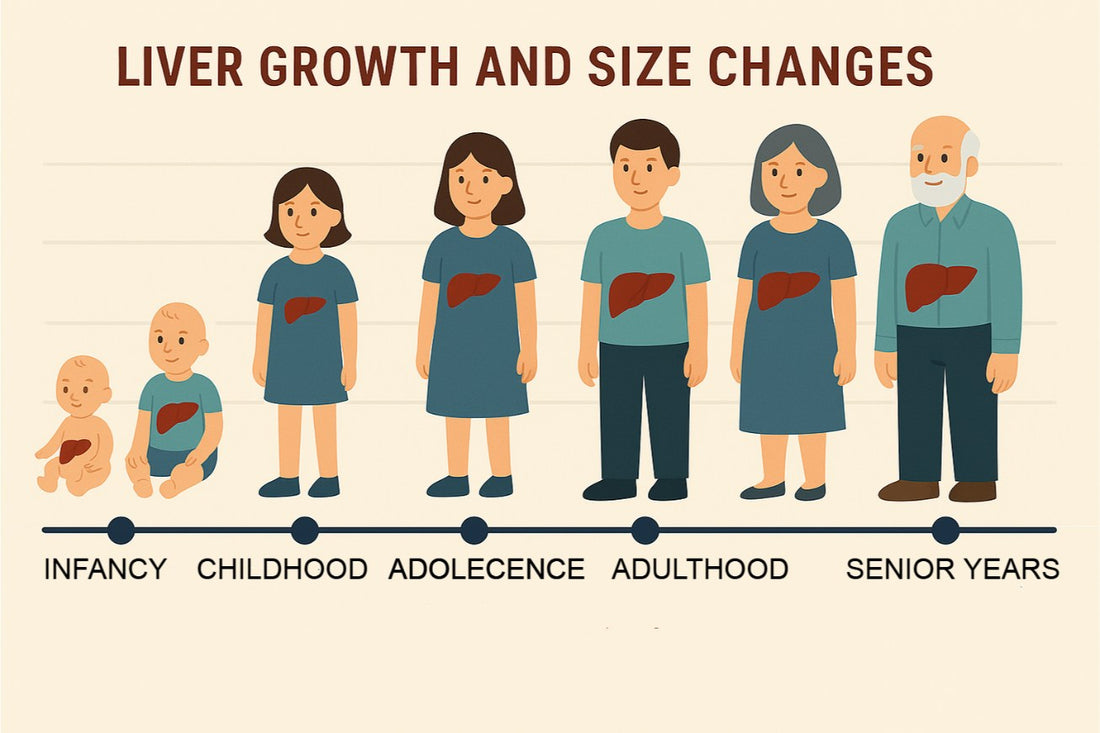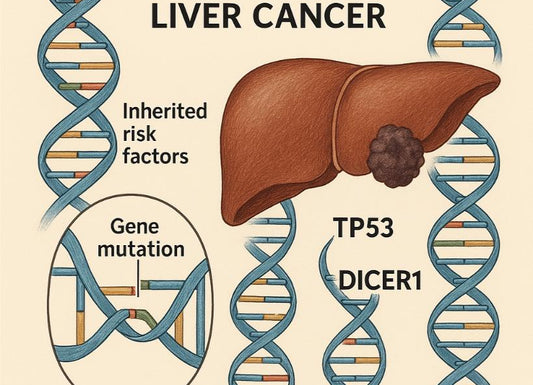Normal Liver Size in cm by Age
 Written By
Abel Tamirat, MD
Written By
Abel Tamirat, MD

The liver is a vital organ responsible for more than 500 crucial functions in the body, including metabolic processes, detoxification, and storage and synthesis of vital nutrients. Monitoring liver health is important for both early disease detection and management of existing conditions. One key indicator of liver health is its size. Liver size can vary significantly based on factors such as age, gender, body weight, and overall health.
This blog will explore the normal liver size in centimeters (cm) by age, its significance, and how to measure it. Whether you’re a healthcare professional, a parent concerned about your child’s health, or an individual monitoring your wellness, this guide offers valuable insights.
Why Knowing Liver Size Matters
Liver size can be an indicator of health status. Enlarged or shrunken livers often signal underlying conditions such as fatty liver disease, hepatitis, or cirrhosis. By understanding normal liver measurements by age and gender, you can better gauge when medical attention might be necessary.
This guide will cover:
-
Average liver sizes across different ages
-
How gender and other factors influence liver size
-
Measuring liver size using modern medical techniques
-
What changes in liver size may signal about your health
What is the Normal Liver Size?
Defining Normal Liver Size
The "normal" size of a liver varies according to age, gender, body weight, and health conditions. Typically, an adult male’s liver measures about 13-15 cm in length, while an adult female’s liver ranges from 12-14 cm. However, these measurements change as we transition from infancy to adulthood.
Factors influencing normal liver size include:
-
Age: Liver size increases with age during childhood and stabilizes in adulthood.
-
Gender: Men generally have larger livers than women due to differences in body mass.
-
Body Size and Weight: Taller and heavier individuals often have larger livers.
-
Health Conditions: Conditions like fatty liver disease, hepatitis, or metabolic disorders can alter the liver's dimensions.
Normal Liver Size in cm by Age

Infants and Toddlers (0-2 Years)
At birth, the liver constitutes a significant portion of the total body weight, making it relatively larger compared to adults. The typical liver measurement for infants is:
-
6.5-8.6 cm in length.
Children and Teenagers (3-18 Years)
As children grow, so does their liver. Normal liver measurements for children are as follows:
-
3-6 years: 9.0–10.8 cm
-
7-12 years: 10.8–12.6 cm
-
13-18 years: 12.5–14.5 cm
Adults (18-65 Years)
Adult liver sizes remain fairly consistent throughout most of life, influenced mainly by gender:
-
Males: 13-15.5 cm
-
Females: 12-14.5 cm
Elderly Individuals (65+ Years)
With age, the liver may undergo slight reductions in size due to changes in metabolism and liver cell regeneration:
-
Average is 11.5-13 cm, slightly smaller than that of younger adults.
Normal Liver Size in cm by Age and Gender
Males vs. Females
Males generally have larger livers than females, reflecting overall differences in body size and weight. On average:
-
Male adult liver size ranges around 13-16 cm.
-
Female adult liver size is generally 12-14 cm.
Impact of Hormonal and Biological Factors
Research suggests that hormonal differences might contribute to varying liver functions and dimensions between genders, with males showing slightly larger liver spans during adulthood.
Measuring Liver Size
Techniques for Liver Measurement
Accurate liver size assessments are typically performed using medical imaging. The most common methods include:
-
Ultrasound: The preferred and safest method for capturing liver dimensions; provides reliable liver span data.
-
CT Scan or MRI: Used for more detailed liver imaging in complex cases.
-
Percussion and Palpation: Traditional physical examination methods, less accurate than imaging.
Measuring Normal Liver Span
The liver span is commonly measured along the midclavicular line, an imaginary line drawn from the middle of the collarbone vertically downward. This guideline ensures consistent and reliable measurements.
Common Questions About Liver Size
Is a 16 cm liver size considered normal in adults?
Yes, a liver measurement of 16 cm can be normal for taller or larger-built individuals, especially males. However, anything above 16 cm in smaller individuals may require further evaluation.
Is a 20 cm liver size within the normal range?
No, a 20 cm measurement significantly exceeds the normal range. This often suggests hepatomegaly (enlarged liver) due to underlying medical conditions such as fatty liver disease or hepatitis.
What is the normal liver size in cm for teenagers?
Normal liver size for teenagers typically ranges between 12-14.5 cm, depending on their height, weight, and overall development.
Liver Size and Health Conditions
Hepatomegaly (Enlarged Liver)
Causes: Fatty liver disease, alcohol abuse, viral hepatitis, or congestive heart failure.
Symptoms: Abdominal fullness, pain, or a visible enlarged abdomen.
Fatty Liver Disease
Impact: Excess fat deposits enlarge the liver, pushing its measurements beyond the normal range.
Solution: Lifestyle changes like weight loss and reduced alcohol consumption can reverse early fatty liver stages.
Cirrhosis
Effect: Scarring reduces liver size over time. Advanced cirrhosis can shrink a liver below normal size.
Liver Tumors

Both benign (non-cancerous) and malignant (cancerous) growths can alter liver size and composition, often requiring surgical intervention.
How Liver Size Changes with Age, Weight, and Lifestyle
Weight and Liver Size
Weight gain often enlarges the liver due to fatty deposits. Conversely, rapid weight loss or malnutrition can reduce its size.
Lifestyle Factors
-
Diet: A balanced diet low in saturated fats promotes a healthy liver.
-
Alcohol Use: Regular alcohol consumption enlarges the liver.
-
Exercise: Keeps the liver healthy and reduces fatty deposits.
Medications and Supplements
Some drugs, like certain antibiotics or steroids, can temporarily affect liver health and size. Always use medications as prescribed.
Special Populations
Pregnancy
Expecting mothers experience minor liver changes due to increased blood flow and changing hormones, although size generally remains within normal ranges.
Athletes
Endurance athletes may have slightly larger livers due to consistent physical activity and optimal cardiovascular health.
Individuals with Chronic Conditions
Diseases like diabetes or hypertension often enlarge the liver due to metabolic strain.
Global Liver Size Trends & Ethnic Variations
Geographic Variation
Liver size trends differ by region. For example, studies indicate that liver sizes in some African and Asian populations are generally smaller than in Western populations, primarily due to differences in diet and genetics.
Genetic Factors
Inherited traits can influence the makeup and dimensions of the liver. For example, familial predispositions to liver diseases alter liver size.
Normal Liver Size in cm: Ultrasound Measurement Guidelines
When a doctor or a rdaiologist measures your liver size via an ultrasound, they're looking for:
-
Adult Normal: Below 16 cm
-
Enlarged (Hepatomegaly): >16 cm
-
Small (Atrophy): <10 cm
Early detection of abnormal liver size ensures timely diagnosis and treatment.
Your Liver, Your Health
Knowing your liver size is not just about numbers. Variations can reveal early symptoms of conditions that could be reversible with lifestyle changes or medical intervention. Stay proactive by:
-
Scheduling regular health check-ups.
-
Maintaining a balanced diet and limiting alcohol consumption.
-
Exercising regularly.
Supporting Liver Health from Home
Tracking liver health doesn’t always require a clinic visit.
Ribbon Checkup offers at-home urine dipstick kits that work with a mobile app to help monitor health indicators, including markers that may be affected by liver function. While not a diagnostic tool, it can support ongoing health awareness and early conversations with your doctor.
Visit ribboncheckup.com to learn more.
Related Resources
- Can Running Cause Elevated Liver Enzymes?
- How To Monitor Liver Health with At Home Test? – Ribbon Checkup
- Can You Get Disability for Cirrhosis of The Liver?
-
Accurate at-home liver test for comprehensive health monitoring
References
Nall, R. (2020, March 9). What Does Liver Size Say About My Health? Retrieved April 4, 2025, from Healthline website: https://www.healthline.com/health/normal-liver-size
Patzak, M., Porzner, M., Oeztuerk, S., Mason, R. A., Wilhelm, M., Graeter, T., … Akinli, A. S. (2014). Assessment of liver size by ultrasonography. Journal of Clinical Ultrasound, 42(7), 399–404. https://doi.org/10.1002/jcu.22151
UpToDate. (2025). Retrieved April 4, 2025, from Uptodate.com website: https://www.uptodate.com/contents/overview-of-the-evaluation-of-hepatomegaly-in-adults/print
Wolf, D. C. (2025). Evaluation of the Size, Shape, and Consistency of the Liver. Retrieved April 4, 2025, from Nih.gov website: https://www.ncbi.nlm.nih.gov/books/NBK421/
Zuhal Bayramoğlu, Hakan Ayyıldız, & Ersoy, B. (2022). Reference Ranges of Age-Based Liver, Spleen, Pancreas, and Kidney Size in Conjunction with Waist Circumference in Children. Turkish Archives of Pediatrics, 57(2), 175–185. https://doi.org/10.5152/turkarchpediatr.2022.21097
Cullen, J. M., & Stalker, M. J. (2016). Liver and Biliary System. Jubb, Kennedy & Palmer’s Pathology of Domestic Animals: Volume 2, 258-352.e1. https://doi.org/10.1016/b978-0-7020-5318-4.00008-5

Dr. Abel Tamirat is a licensed General Practitioner and ECFMG-certified international medical graduate with over three years of experience supporting U.S.-based telehealth and primary care practices. As a freelance medical writer and Virtual Clinical Support Specialist, he blends frontline clinical expertise with a passion for health technology and evidence-based content. He is also a contributor to Continuing Medical Education (CME) programs.




